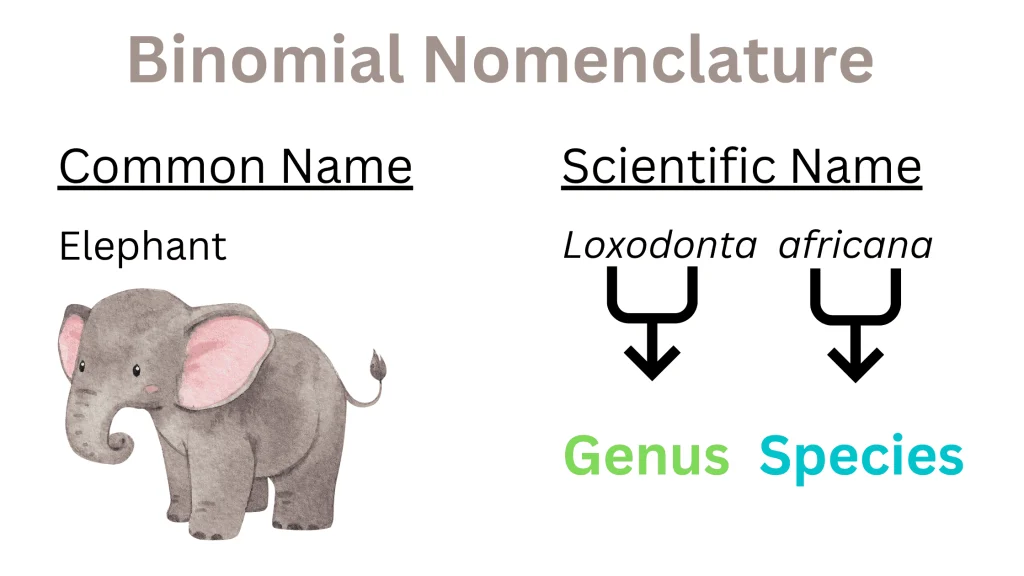Introduction
The binomial nomenclature system is used for giving scientific names to living organisms, in which each species is given a unique name that consists of two parts: the genus and the Specific epithet. This system was developed by the Swedish naturalist Carolus Linnaeus in the 18th century and is still used today to classify and name organisms in biology.

Rules of Binomial Nomenclature
There are several rules that govern binomial nomenclature, as established by the International Code of Nomenclature for algae, fungi, and plants (ICN) and the International Code of Zoological Nomenclature (ICZN). Here are some of the main rules:
- The name of a species must consist of two parts: the genus name, which is the first part, and the specific epithet, which is the second part.
- The two parts of the name are always written in italics, and the specific epithet is written in lowercase. For example, the name of the human species is Homo sapiens, where “Homo” is the genus name and “sapiens” is the specific epithet. (In either the hard copy or the soft copy, the names should be written in italic font. Eg. Homo sapiens.)
- In the case of handwritten notes, each of the names should be underlined separately. Eg. Homo sapiens.
- There is also the option to include the author’s name, so in that case, the author’s name is abbreviated and placed after the species name, followed by a space. Examples include Mangifera indica Linn, where Linn stands for Carolus Linnaeus.
- The name of a species must be unique and not be used for any other species.
- The name of a species must be based on a type specimen, which is a representative specimen that serves as the standard for the species. The name of a species must be based on the characteristics of the type specimen.
- The name of a species must be published in a scientific journal or other publication that is widely available to scientists.
- The name of a species must be written in Latin or in a modern language that is Latin-based, such as English, French, or Spanish.
- The name of a species must not be based on subjective criteria, such as the appearance of the organism or the feelings of the person naming it.
- The name of a species must not be based on personal or geographical names unless the person or place has made a significant contribution to the field of biology.
- The name of a species must not be based on language or cultural biases.
- The name of a species must not be based on a hybrid or a cultivar unless the hybrid or cultivar is widely accepted as a natural species.
- The name of a species must not be changed unless there is a compelling scientific reason to do so.
Significance:
The importance of binomial nomenclature lies in its ability to provide a unique and universally recognized name for each species. This allows scientists and researchers to clearly communicate about specific organisms and to accurately identify and classify them.
The simple name has no scientific basis. At old-time one species have given many names in a region such as Payaz in English Onion in Punjabi Gunda in sirayki Basal or Vassal. Different languages have different names but in science, they have only one name Alium cepa another example blackbird is given the name Ravan and as well as crow but in science, they have only one name Curvous splender.
Overall, binomial nomenclature is an essential tool in the field of biology that helps to organize and classify the vast diversity of life on Earth.
Examples of Binomial Nomenclature
| Common Name | Scientific Name | Genus | Species |
| Pig tapeworm | Taenia solium | Taenia | solium |
| Roundworm | Ascaris lumbricoides | Ascaris | lumbricoides |
| Beef tapeworm | Taenia saginata | Taenia | saginata |
| Rice | Oryza sativa | Oryza | sativa |
| Mango | Magnifera indica | Magnifera | indica |
| Soybean | Glycine max | Glycine | max |
| Potato | Solanum tuberosum | Solanum | tuberosum |
References:
- https://biologydictionary.net/binomial-nomenclature-rules/
- https://www.vedantu.com/biology/binomial-nomenclature
- https://byjus.com/biology/binomial-nomenclature/
- Binomial nomenclature. (n.d.). In Wikipedia. Retrieved June 17, 2017 from https://en.wikipedia.org/wiki/Binomial_nomenclature
